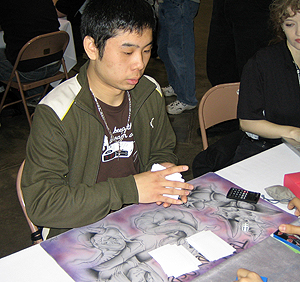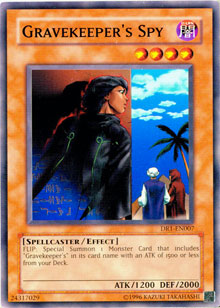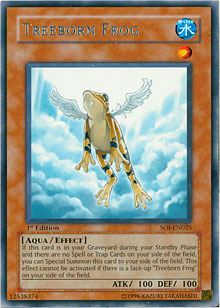
Welcome to the first of my next series of articles! “The Champions” is going to be about decks. Not just any decks, though—in this column, I’ll be looking at the decks that were piloted to Shonen Jump Championship Top 8 spots and high finishes in other events, as well as anything innovative and creative that captures my attention. They won’t always be the winner’s decks, and they won’t always be the best decks of the tournament. However, they will definitely have something unique about them. Whether it’s the theme, the tech, or the play style, I assure you that you’ll look at every deck differently by the end of the game.
 This week, we’ll take a look at Jerry Wang’s most recent concoction. The deck doesn’t appear to have any real theme, beyond a rather soft Monarch Control notion among a lot of random single copies of cards. It’s perfect for a Shonen Jump decklist, however. Remember, consistency will win you matches, but flexibility will win you tournaments. Knowing how to perfectly manage your cards can only get you so far, because Shonen Jump Championships are meant to test your deck and your play style, not just your hand management skills. I can’t stress the importance of having a loose play style enough. When you’re going into a match, you can’t have a game plan. If you depend on your deck to do the exact same thing in every single game, you won’t get very far in a nine-round tournament.
This week, we’ll take a look at Jerry Wang’s most recent concoction. The deck doesn’t appear to have any real theme, beyond a rather soft Monarch Control notion among a lot of random single copies of cards. It’s perfect for a Shonen Jump decklist, however. Remember, consistency will win you matches, but flexibility will win you tournaments. Knowing how to perfectly manage your cards can only get you so far, because Shonen Jump Championships are meant to test your deck and your play style, not just your hand management skills. I can’t stress the importance of having a loose play style enough. When you’re going into a match, you can’t have a game plan. If you depend on your deck to do the exact same thing in every single game, you won’t get very far in a nine-round tournament.
I know, that was a bomb. I realized this startling fact after Shonen Jump Columbus. I thought to myself, “How could Canada send what many believe to be some of the best players in the country and place only one member in the Top 8 with an 8-2 record?” Well, we didn’t embarrass ourselves exactly. Lazaro Bellido ended up eighth and Andrew Hayton barely lost out, ending in ninth place for a second time. I myself went 8-2, finishing seventeenth, while Dale Bellido and Rob Cedar both went 7-3. The other members dropped after only two losses to participate in the side events.
How could this happen? We had playtested every deck and every match-up for weeks. We knew our decks inside and out, we knew what we had to do, and we knew we had the skills to do it. The short answer? We weren’t prepared enough. We found out the hard way that one can never anticipate exactly what will happen in a Shonen Jump Championship. With so many different players, play styles, cards, decks, tech, and ideas, one could go through nine rounds of a Shonen and never win the same way twice. You have to deal with many unanticipated situations in a tournament, and because of this, you’ll never know what cards are going to be used against you or what cards are going to be most useful to you. What’s the best thing to do, then? Play as many different cards as you can, and cards that can handle multiple situations differently are especially valuable. Apprentice Magician and Enemy Controller are two such cards that could help you play competitively in many different scenarios.
Which brings us to Jerry Wang, a top-notch competitor from Team Overdose. His Top 8 decks have been some of the most unexpected, yet he continues to dominate the field with them. Let’s take a look at the Monarch Control deck that he played in Columbus:
Monsters: 22
1 Chaos Sorcerer
2 Mobius the Frost Monarch
2 Zaborg the Thunder Monarch
1 Thestalos the Firestorm Monarch
1 Cyber Dragon
1 Breaker the Magical Warrior
1 Dekoichi the Battlechanted Locomotive
2 Gravekeeper's Spy
1 Tsukuyomi
1 Sangan
1 Skelengel
1 Morphing Jar
1 Apprentice Magician
2 Magician of Faith
2 Spirit Reaper
1 Magical Merchant
1 Treeborn Frog
Spells: 13
1 Pot of Avarice
1 Graceful Charity
1 Heavy Storm
1 Snatch Steal
1 Mystical Space Typhoon
1 Confiscation
1 Brain Control
1 Soul Exchange
1 Smashing Ground
1 Book of Moon
2 Nobleman of Crossout
1 Scapegoat
Traps: 6
1 Royal Decree
1 Mirror Force
1 Torrential Tribute
2 Sakuretsu Armor
1 Bottomless Trap Hole
Side Deck: 15
1 Chaos Sorcerer
1 Night Assailant
1 Cyber Dragon
1 D. D. Warrior Lady
1 Jinzo
1 Dekoichi the Battlechanted Locomotive
1 Mystic Swordsman LV2
2 Dust Tornado
2 Return from the Different Dimension
1 Royal Decree
1 Des Wombat
1 Goldd, Wu-Lord of Dark World
1 Bottomless Trap Hole
 As you can see, Jerry’s deck is as flexible as possible. The monster lineup is made up of five Monarchs, each of which can take control of the game. To make up for a high amount of tributes, Jerry also plays a group of very defensive monsters. Gravekeeper’s Spy, Apprentice Magician, and Spirit Reaper are great examples of defensive monsters that can set up big tributes (and also double up as scenario-breakers). All of these monsters are incredibly flexible, both on offense and defense, and all of them can help you out when you’re in a bind.
As you can see, Jerry’s deck is as flexible as possible. The monster lineup is made up of five Monarchs, each of which can take control of the game. To make up for a high amount of tributes, Jerry also plays a group of very defensive monsters. Gravekeeper’s Spy, Apprentice Magician, and Spirit Reaper are great examples of defensive monsters that can set up big tributes (and also double up as scenario-breakers). All of these monsters are incredibly flexible, both on offense and defense, and all of them can help you out when you’re in a bind.
The rest of Jerry’s lineup is filled with standard monsters that help him find more options or deal with situations. As such, his monster lineup falls into the toolbox style. Though they don’t have the power of Reinforcement of the Army behind them in the way that Warriors do, Jerry’s entire deck is a toolbox, so there’s no need to search for anything specific.
The spell lineup is geared towards helping maintain consistency in the deck. Brain Control, Soul Exchange, and Scapegoat help Jerry pull out of tough tribute-heavy hands. The standard spells have found a home in this deck to help promote the scenario-combat theme. Jerry also plays one copy of Pot of Avarice in almost every deck he makes. After watching Jerry play, I’ve found that he’s one of the best at making dead cards work and setting up scenarios in which less useful cards will tear the game open. I watched a fist-hand lesson in this during his quarterfinal match up with Carlos Santiago at Shonen Jump Columbus. He set up the “pro-Storm”* perfectly, and baited Carlos right into his hands. This broke open the game and allowed Jerry to take the match.
Jerry’s trap lineup works to help him pull out of some tough spots. Comprised of a handful of defensive cards, it’s clear that Jerry used his traps to take down bigger monsters and pave a path for his Monarchs. Defense cards also allow Jerry to keep his monsters on the field to tribute, and again, they help him escape some sticky situations.
 Jerry’s deck has received a lot of criticism for main decking Royal Decree while also playing Treeborn Frog. This is a reasonable critique, since a handful of Monarchs means that Jerry must rely on Treeborn Frog a great deal. However, I believe that the Royal Decree is a metagame call. It helps Jerry put a stop to Return from the Different Dimension, and can lend a hand against rogue decks. But like all the cards that Jerry plays, it’s quite versatile. After Jerry’s Monarchs have stomped their way through the opponent’s field, he could drop the Decree and begin the siege on the other player’s life points.
Jerry’s deck has received a lot of criticism for main decking Royal Decree while also playing Treeborn Frog. This is a reasonable critique, since a handful of Monarchs means that Jerry must rely on Treeborn Frog a great deal. However, I believe that the Royal Decree is a metagame call. It helps Jerry put a stop to Return from the Different Dimension, and can lend a hand against rogue decks. But like all the cards that Jerry plays, it’s quite versatile. After Jerry’s Monarchs have stomped their way through the opponent’s field, he could drop the Decree and begin the siege on the other player’s life points.
From looking at this deck, it’s clear that Jerry plays reactively. He lets his opponent decide on a game plan before making his own, which trumps whatever his opponent has in mind. Once his opponent has nowhere to go and nothing to do, Jerry starts going for the life points. He also plays conservatively, poking with floaters like Dekoichi the Battlechanted Locomotive and Magician of Faith. He lets his opponents use their best cards and exhaust all options before he commits to any play.
This is the type of play style that you need to win a Shonen Jump Championship. While Jerry has always fallen short of this feat, he’s joined the four-time Top 8 club to show for his efforts. His play style matches perfectly with his deck, and it’s tearing apart every opponent he plays. You can’t argue with that kind of success.
*“Pro-Storm” is setting Heavy Storm in order to make your opponent feel safer in setting spells or traps. If your opponent counts your face-down Heavy Storm as a liability against you, should you play Heavy Storm from your hand, they’ll be willing to match your liability. Flipping Heavy Storm means you’ve drawn out an additional card from your opponent.